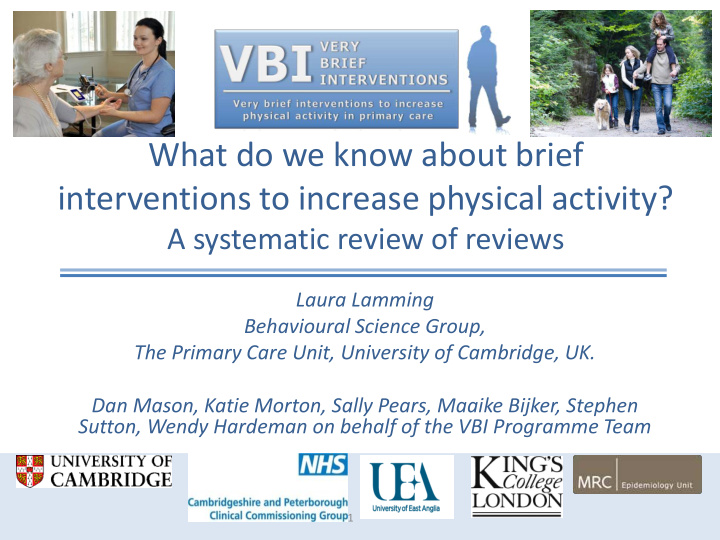



What do we know about brief interventions to increase physical activity? A systematic review of reviews Laura Lamming Behavioural Science Group, The Primary Care Unit, University of Cambridge, UK. Dan Mason, Katie Morton, Sally Pears, Maaike Bijker, Stephen Sutton, Wendy Hardeman on behalf of the VBI Programme Team 1
Background Low levels of physical activity (PA) are associated with significant disease burden (1) Primary care providers have access to large proportion of public BUT have time constraints PA interventions may be easier to integrate into routine primary care if they were brief Recent policy initiatives and guidance encourage use of brief interventions But, NO agreed definition of a brief intervention 1 – Lee, I., Shiroma, E. J., et al. (2012). “Effect of physical inactivity on major non -communicable diseases worldwide: an analysis of burden of disease and life expectancy.” The Lancet 380 (9838): 219-229. 2
Objectives What do we know about brief interventions (BIs) to increase PA that could be delivered in a primary care setting? How are BIs defined? Do BIs increase physical activity levels, and compared to what? Which factors influence their effectiveness? Who are they effective for? Are they feasible and acceptable? 3
Standard systematic review methodology Data extraction Criteria Double checked PA interventions only Systematic review/Meta- analysis Adults, no PA rehabilitation Descriptive data PA outcome Individual level Narrative Synthesis Findings/Discussion of BIs 4
Results
Study selection Records identified from Records identified from authors collection: N=4 electronic databases: N=11993 Records after duplicates removed N=5803 Records identified from For Title screening N=5803 Excluded: N=5561 ineligible comments: N=3 Excluded: N=88 For Abstract screening* N=242 Additional records For Full Text screening*: N=154 Excluded: N= 145 identified: N=1 For Synthesis N= 10 * Double screened 6
1. Definitions of brief interventions 3/10 reviews gave definitions of BIs Agreed that BIs, at their most minimal, could include advice, verbal or otherwise, of a short duration One review specified a maximum duration (30 minutes), and two included interventions of up to 30 or 40 minutes 7
2. Effectiveness of brief interventions Reviews support the effectiveness of BIs on self- reported physical activity in the short-term (6 weeks- 12 months) Lack of evidence/support for their effectiveness in the long term and their impact on objectively measured physical activity 8
3. Factors that impact on the effectiveness of brief interventions Reviews support the use of high quality supplementary written materials Lack of/inconclusive evidence for the impact of duration, type of provider, setting and theoretical basis 9
4. Population characteristics Inconclusive and limited evidence for the impact of targeting BIs at participants on the basis of various characteristics, e.g.: – Age – Gender – Current activity level – Health status – Socio-economic status 10
5. Feasibility and acceptability of brief interventions Reviews report that the following factors can impact feasibility and acceptability of BIs for patients and practitioners: practitioner patient intervention content structural factors (e.g. time constraints) 11
Key Conclusions 2/3 of the reported definitions of BIs include interventions too long for routine primary care consultations Future research should develop and evaluate very brief interventions (VBIs) that could fit into a routine primary care consultation More evidence is needed about the long – term effectiveness of BIs for objectively measured and self-reported physical activity 12
Thanks & Questions? Special thanks: Isla Kuhn (Librarian) Sophie Attwood Author: ll356@medschl.cam.ac.uk VBI programme: VBI@medschl.cam.ac.uk VBI webpage: http://tiny.cc/VBIprog This presentation presents independent research funded by the National Institute for Health Research (NIHR) under its Programme Grants for Applied Research Programme (Grant Reference Number RP-PG-0608-10079). The views expressed are those of the author(s) and not necessarily those of the NHS, the NIHR or the Department of Health. 13
Recommend
More recommend